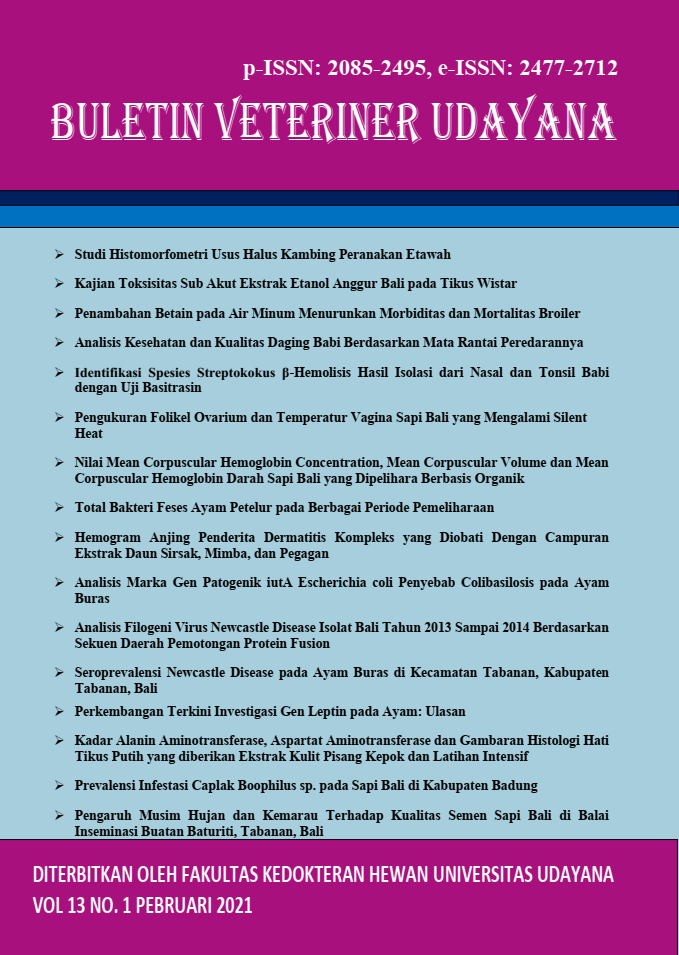ANALYSIS OF PATHOGENIC IUTA GENE MARKERS IN ESCHERICHIA COLI CAUSES OF COLLIBACILLOSIS IN FREE-RANGE CHICKEN
Abstract
Colibacillosis is an infectious disease in chickens caused by Avian Pathogenic Escherichia coli (APEC). The ability of APEC to cause disease depends on many pathogenic factors, one of which is the iutA pathogenic gene. This study was purposed to determine the DNA sequence of the APEC iutA gene in Bali and its kinship with the iutA gene from other countries. Two APEC isolates from free-range chicken in Tabanan dan Badung has been used. The isolates have been purified and were available at the Bacteriology Laboratory of Veterinary Medicine Faculty, Udayana University. Chelex 10% was used for DNA isolation. DNA amplification using published DNA primer has been conducted with the polymerase chain reaction (PCR) method. The PCR product was sequenced at Malaysia, First Base Laboratories using Sanger’s Dideoxy Nucleotide Termination method. The iutA gene of both isolates can be analyzed and have 250 bp in length. Both were 100% homologous. A phylogenic test using 58 DNA sequences of iutA gene from Escherichia coli and other bacteria in the world was conducted in MEGA 5.2. All data have 43 polymorphic sites of nucleotide acid and 13 polymorphic sites of amino acid. The iutA gene from Bali is in one group, with the iutA gene from Brazil (KP657535) in 2011, Germany (LT599825) in 2016, and China (CP033635) in 2016. This gene can be used as a pathogenic marker of APEC in Indonesia.
Downloads
References
Barus DO, Gelgel KTP, Suarjana IGK. 2013. Uji kepekaan bakteri escherichia coli asal ayam pedaging terhadap antibiotik doksisiklin, gentamisin, dan tiamfenikol. Indonesia Medicus Veterinus. 2(5): 538-545.
Brown TA. 1992. Genetics: Molecular Approach, Second Edition. Chapman & Hall, London.
Boe L, Danielsen M, Knudsena S, Petersen JB, Maymann J, Jensen PR. 2000. The frequency of mutators in populations of Escherichia coli. Mutation Res. Fund. Mol. Mechanisms Mutagenesis. 448(1): 47–55.
Guabiraba R, Schouler C. 2015. Avian colibacillosis: still many black holes. FEMS Microbiol. Letters. 362(12): 1-8.
Handoyo D, Rudiretna A. 2000. Prinsip umum dan pelaksanaan polymerase chain reaction (PCR). Unitas, 9(1):17-29
Johnson TJ, Siek KE, Johnson SJ, Nolan LK. 2006. DNA sequence of a coiv plasmid and prevalence of selected plasmid-encoded virulence genes among avian escherichia coli strains. J. Bacteriol. 188(2): 745-758.
Johnson TJ, Wannemuehler Y, Doetkott C, Johnson SJ, Rosenberg SC, Nolan LK. 2008. Identification of minumal predictors of avian pathogenic escherichia coli virulence for use as a rapid diagnostic tool. J. Clin. Microbiol. 46(12): 3987-3996.
Kabir SML. 2010. Avian colibacillosis and salmonellosis: a closer look at epidemiology, pathogenesis, diagnosis, control and public health concerns. Int. J. Environ. Res. Pub. Health. 7(1): 89-114.
Kibota TT, Lynch M. 1996. Estimate of the genomic mutation rate deleterious to overall fitness in E. coli. Nature. 381(6594): 694–696.
Landman WJMM, van Eck JHH. 2016. The incidence and economic impact of the Escherichia coli peritonitis syndrome in Dutch poultry farming. Avian Pathol. 44(5): 370-378.
Lau GL, Sieo CC, Tan WS, Ho YW. 2012. Characteristic of phage effective for colibacillosis control in poultry. J. Sci. Food Agric. 92(13): 57-63.
Luhung YGA, Suarjana IGK, Gelgel KTP. 2017. Sensitivitas isolat escherichia coli patogen dari organ ayam pedagng terinfeksi koliseptisemia terhadap oksitetrasiklin, ampisilin dan sulfametoksazol. Buletin Veteriner Udayana. 9(1): 60-66.
Lynne AM, Kariyawasam S, Wannemuehler Y, Johnson TJ, Johnson SJ, Sinha AS, Lynner DK, Moon HW, Jordan DM, Logue CM, Foley SL, Nolan LK. 2012. Recombinant iss as a potential vaccine for avian colibacillosis. Avian Dis. 56(1): 192-199.
Rodriguez-Siek KE, Giddings CW, Doetkott C, Johnson TJ, Nolan LK. 2005. Characterizing the APEC pathotype. Vet. Res. 36(2): 241–256.
Schouler C, Schaeffer B, Brée A, Mora A, Dahbi G, Biet F. 2012. Diagnostic strategy for identifying avian pathogenic escherichia coli based on four patterns of virulence genes. J. Clin. Microbiol. 50(5): 1673–1678.
Tabrah FL. 2011. Koch’s postulates, carnivorous cows, and tuberculosis today. Hawai‘i Med. J. 70(7): 144-148.
Tamura K, Peterson D, Peterson N, Stecher G, Nei M, Kumar S. 2011. MEGA5: molecular evolutionary genetics analysis using maximum likelihood, evolutionary distance, and maximum parsimony methods. Mol. Biol. Evol. 28(10): 2731-2739.
Tarmudji. 2003. Kolibasiolosis pada ayam: etiologi, patologi dan pengendaliannya. Wartazoa 13(2):65-73.
Uotani Y, Kitahara R, Imai T, Tsutsumi N, Sasakawa C, Nagai S, Nagano T. 2017. Efficacy of an avian colibacillosis live vaccine for layer breeder in Japan. J. Vet. Med. Sci. 79(7): 1215–1219.
Walsh SP, Metzger DA, Higuchi R. 1991. Chelex 100 as a medium for simple extraction of DNA for PCR-based typing from forensic material. Biotechniques. 10(4): 506-513.
Wang J, Tang P, Tan D, Wang L, Zhang S, Qiu Y, Dong R, Liu W, Huang J, Chen T, Ren J, Lil C, Liu H. 2015. The pathogenicity of chicken pathogenic escherichia coli is associated with the numbers and combination patterns of virulence-associated genes. J. Vet. Med. 5: 243-254.
Whittam TS, Wilson RA. 1988. Genetic relationships among pathogenic strains of avian Escherichia coli. Infect. Immun. 56(9): 2458–2466.





